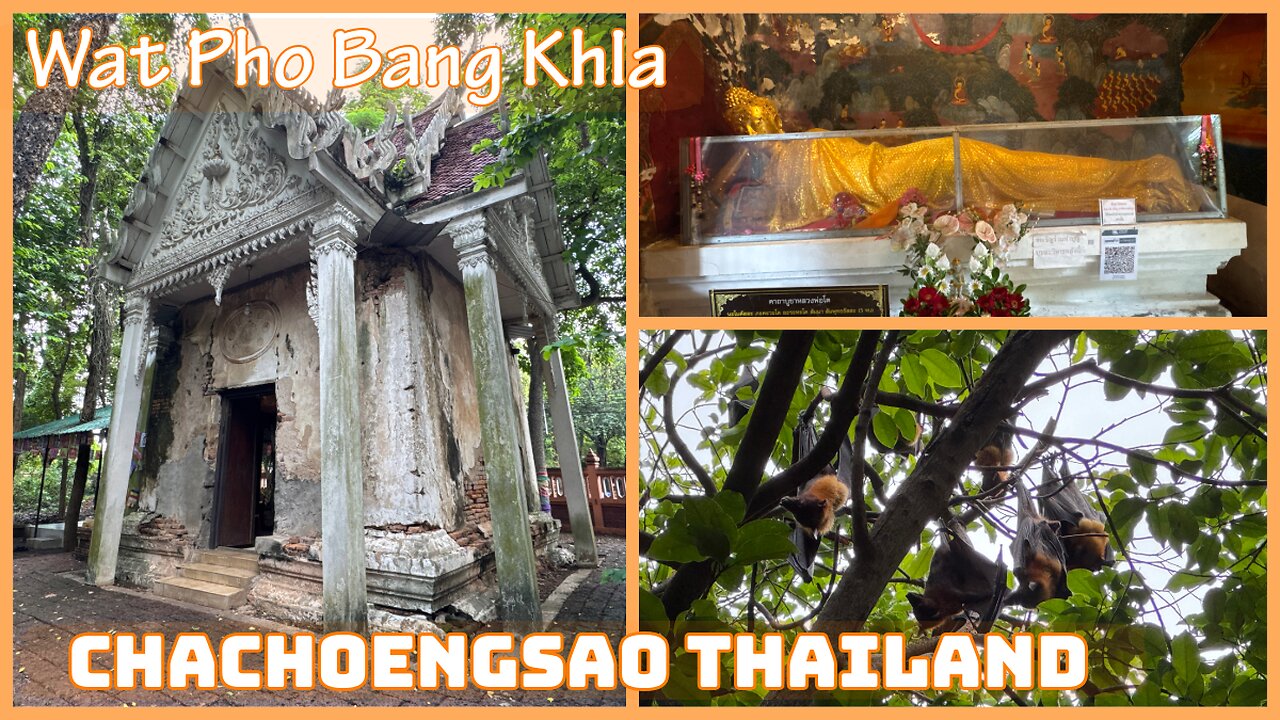Premium Only Content

The Flying Fox Temple of Wat Pho Bang Khla: Thailand’s Hidden Wonder
Wat Pho Bang Khla (วัดโพธิ์บางคล้า), often called the “Temple of the Flying Foxes,” is a historic Buddhist temple located in Bang Khla District, Chachoengsao Province, Thailand. Situated along the serene Bang Pakong River, it’s about 23 km southeast of Chachoengsao city center and roughly 1.5–2 hours’ drive from Bangkok.
This temple blends spiritual tranquility with a unique natural spectacle, making it a hidden gem for visitors seeking an off-the-beaten-path experience away from Thailand’s more crowded tourist sites.
Built during the late 18th century (around 1767–1807), the temple dates back to the era of King Taksin the Great, who reportedly passed through the area with his army after the fall of Ayutthaya to the Burmese in 1767. It was constructed to commemorate this historical moment, serving as a reminder of Thailand’s resilience during that turbulent period.
The architecture fuses Ayutthaya and early Rattanakosin styles, featuring intricate brickwork, vibrant murals depicting the life of Buddha, and a charming, understated charm with exposed bricks and shaded pavilions.
The temple grounds span about 49,600 square meters (roughly 12 acres), including a large viharn (prayer hall) that houses statues of revered monks and important Buddha images from across Thailand.
It’s also home to sacred amulets, including the “Five Benjapake” (five grand amulets): Phra Lod Muang Lamphun, Phra Somdej Wat Rakhang, Phra Nang Phaya Phitsanulok, Phra Chum Ko, and Phra Phong Suphan. In front of the temple stands a century-old hall enshrining “Luang Pho To,” a revered Buddha statue. A small, rustic mondop (tower-like structure) from King Taksin’s time adds to the historical allure, with interior paintings illustrating Buddhist tales.
What truly sets Wat Pho Bang Khla apart is its massive colony of Lyle’s flying foxes (Pteropus lylei), a species of fruit bat native to Thailand, Cambodia, and Vietnam. These mega-bats, with wingspans up to nearly 1 meter (3 feet), number in the hundreds of thousands and roost in the temple’s ancient trees during the day. They hang upside down, preening and occasionally squabbling, creating a furry canopy that’s both mesmerizing and slightly eerie. Visitors often describe it as a “living spectacle” or “flying fox sanctuary.”
Arrive in the late afternoon (around 4–6 PM) to watch them take flight at dusk, silhouetted against the sky as they head out to feed on fruits (curiously, they avoid local Bang Khla fruits and fly toward the Thai-Cambodian border). Early morning returns can also yield sightings.
A small observation tower near the entrance lets you climb up for eye-level views—perfect for photos. The temple’s peaceful riverside setting enhances the experience, with the bats’ flights often visible from the river steps.
The colony has made the site a point of interest for researchers studying bat ecology and even emerging pandemics, due to the high density of these fruit-eaters.
Whether you’re a history buff, nature lover, or just want a quiet escape, Wat Pho Bang Khla offers a rare blend of Thai culture and wildlife that’s well worth the trip.
Enjoy the video!
You can also see my videos on Rumble, Bitchute, Odysee and Subscribe Star. If you have any questions or comments and wish to contact me directly I can be reached by email at [email protected]
https://www.bitchute.com/channel/pYUe8EgYcUMc/
https://odysee.com/$/latest/@EndlessJourney
https://rumble.com/c/EndlessJourney
https://www.subscribestar.com/endless-journey
Follow me on Twitter @AEndlessJourney
#endlessjourney
#travel
#thailand
-
 16:23
16:23
Endless Journey
34 minutes agoBG Pathum United Vs Port FC in 2-0 Thriller! Thai League 1 Highlights Sept 28, 2025
-
 1:00:55
1:00:55
VINCE
2 hours agoSOMBRERO-GATE! | Episode 137 - 10/01/25
54.2K102 -
 LIVE
LIVE
MYLUNCHBREAK CHANNEL PAGE
2 hours ago1000's of Miles of Tunnels
383 watching -
 LIVE
LIVE
The Big Mig™
1 hour agoSchumer Government Shutdown Screwing America AGAIN!
2,650 watching -
 LIVE
LIVE
Bannons War Room
7 months agoWarRoom Live
13,879 watching -
 1:09:26
1:09:26
Benny Johnson
1 hour agoDemocrats Throw Hysterical MELTDOWN As Trump Gives Them 'Trump 2028' Hats, Trolls With 'Racist' Meme
6.5K13 -
 1:35:09
1:35:09
Dear America
3 hours agoDems Cause a Gov SHUTDOWN!! Remember THEY HATE YOU! + Bomb Threat At TPUSA Event!!
73K67 -
 LIVE
LIVE
Badlands Media
9 hours agoBadlands Daily: October 1, 2025
4,031 watching -

Matt Kohrs
11 hours agoGov'nt Shutdown: Stocks Whipsaw, Bitcoin Pops & Gold Hits Record || Live Trading
17.8K1 -
 LIVE
LIVE
Law&Crime
2 hours agoLIVE: Gun-Cleaning Gone Deadly Trial – FL v. Leslie Boileau – Day 1
117 watching